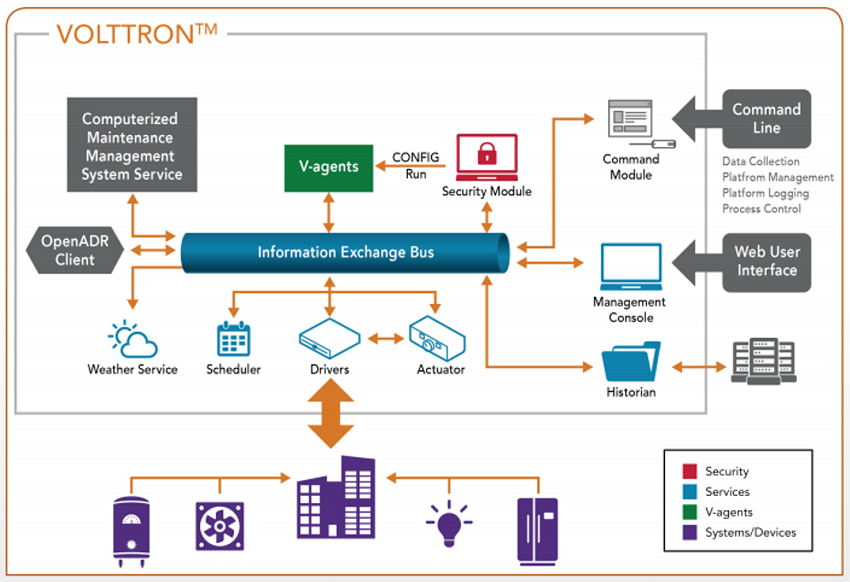|
August 2017
AutomatedBuildings.com
|
[an error occurred while processing this directive]
(Click
Message to Learn More)
|
The Edge of VOLTTRON’s Sword
The pillars of this new platform are flexibility - for a varied set of solution spaces, and usability -
easily accessible to both users and developers. The software stack is
available free on GitHub to put onto a small form factor computer and
create your very own “edge device.”
|

Brad White,
P.Eng, MASc
Principal,
SES Consulting
Inc.
Contributing Editor

Nigel David,
BSc, MSc, PhD,
Lead Researcher
SES Consulting
Inc.
|
Back
in 2010, as part of the “Future Power Grid Initiative” project, a team
from The Pacific Northwest National Laboratory (PNNL) set out to
develop a software platform for the Smart Grid. Specifically, the
platform would enable transactions between electric vehicle chargers
and the grid so the homeowner and the utility could benefit from the
energy stored in a parked car battery. At the time, no existing
platform was available that met the security or resource management
requirements for such a use case.
In 2013, version 1.0 of the platform was
demonstrated in an instrumented house with an EV. It was at around this
time that the team broadened the goals of the software project, made it
open source, and gave it a name: VOLTTRON. “VOLTTRON [would now]
independently manage a wide range of applications, such as HVAC
systems, electric vehicles, distributed energy or entire building
loads, leading to improved operational efficiency.” Any good robot
would do the same, of course.
Fast forward to 2017; version 4.1 has just
been released. Many wide-ranging application concepts have indeed been
proven with the platform. One might even say that it is becoming a
veritable IoT platform built on a secure cyber foundation; a legacy
from the original grid connected use case and the core strengths of the
PNNL team. The pillars of this new platform are flexibility - meeting
the requirements for a varied set of solution spaces, and usability -
easily accessible to both users and developers. The software stack is
available free on GitHub to put onto a small form factor computer and
create your very own “edge device.”
For the building and HVAC space, the
platform speaks BACnet and MODBUS. Out of the box and on a mini pc it
can be used as a data collection device. On a central server, it
becomes a management platform, allowing you to visualize the data and
the performance of your field devices. The beauty of the platform lies
in where you can take it from here. Rule-based AFDD, machine learning
algorithms, and any other data driven applications you can imagine can
all be pushed to the edge.

Overview of the VOLTTRON Platform
The DOE has a mandate that it cannot
develop an open source tool that competes directly with a commercial
product. One of the many metaphors that describes what they can do and
have done though is this: they have presented a cake without icing, on
a silver platter.
Several commercial service providers,
consultants and integrators alike (ourselves included), have started to
use VOLTTRON to support our service offerings, the icing if you will.
In our case, as building optimization consultants, this data is giving
us greater insights into the opportunities that exist to make buildings
work better. The ability to plot, manipulate and visualize large data
sets extracted from the BMS are bringing to light issues that were
previously hidden from view. In other cases, the data allows us to
understand better underlying issues that we always knew were there but
were difficult to quantify in terms of their impact.
For example, we know that we want to try
and maximize our VAV damper positions with a supply air pressure reset
program. But determining how well this is actually working in practice
can be difficult. Previously, we’d be relying on small amounts of data
or snapshots of system operation to try and figure this out. But with
large data sets stretching from months to years, it becomes almost
trivial to analyze average, min and max VAV positions compared to fan
speed and pressure in order to see exactly how much room for
improvement there is. This same sort of analysis can be done on
hydronic heating and cooling systems, comparing supply water
temperatures, pump speeds, and valve positions.
We’ve only started scratching the surface
of interesting things to find. One could imagine using this kind of
data for zone level virtual metering to map energy flows within a
building over time to quickly identify the areas of your building that
are energy hogs. Combining that kind of analysis with information on
hot/cold complaints could yield some extremely valuable insights that
could reduce not only energy consumption but also improve occupant
comfort and satisfaction. Beyond our home-grown analysis, VOLTTRON can
help make the data accessible to 3rd parties who will provide their own
software solutions, whether it be AFDD, optimization, or something else
yet to be invented. The possibilities are limitless.
[an error occurred while processing this directive]VOLTTRON certainly isn’t the only way to
access this kind of data. Most building automation systems have long
had proprietary solutions for long term data archiving. However, these
solutions can be relatively expensive to implement and don’t have a
standard way of storing data, which poses a significant challenge to
anyone trying to analyze it. Comparatively inexpensive 3rd party
solutions for data archiving do exist. However, they too don’t
necessarily have a common way to store or format data and run the risk
of leaving you stranded if the product is suddenly discontinued (we
learned this lesson the hard way). This is where the open source nature
of VOLTTRON is a real advantage, by providing a low-cost
non-proprietary solution that service providers can standardize on,
with assurances that it isn’t going to disappear overnight. Even in the
worst case if development stopped tomorrow, the existing source code
would remain freely available for anyone to continue to
use.
True open source communities have been
relatively rare in the building automation industry; Haystack and
Sedona are the two others that immediately come to mind. It is
our hope that VOLTTRON can become a robust and well-supported platform
with an active community of individuals and organizations dedicated to
further development. Secure and open access to data is fundamental in
realizing the future potential of the building automation
industry.
For more information on VOLTTRON visit
VOLTTRON.org
Further reading available at the following links:
http://www.automatedbuildings.com/news/may17/interviews/170426110404david.html
http://www.contractormag.com/iot/volttron-two-ts
http://www.automatedbuildings.com/news/jun17/reviews/170523044401volttron.html
http://www.automatedbuildings.com/news/may17/interviews/170424121808hernadez.html
About the Authors
Brad
White, P.Eng is a principal at SES Consulting Inc. SES, a
Certified B Corporation, is a Vancouver based firm that helps building
owners reduce energy use and GHG emissions through their expertise in
mechanical systems, building automation, and occupant engagement.
Nigel David, BSc, MSc, PhD, Lead Researcher SES Consulting Inc. Nigel
enjoys building data pipelines across BC and Canada that allow SES’s
engineers to quickly and continuously deliver energy efficiency
solutions. He leads the research and development activities that
complement SES’s core engineering services. Nigel comes from a
background of experimental physics and hydrogen fuel cell research. His
current research interests include the “internet of things”, integrated
energy systems, and the Passive House and WELL building design
standards. When not wrangling data, he can be found wandering the BC
trails and beaches with his family.
footer
[an error occurred while processing this directive]
[Click Banner To Learn More]
[Home Page] [The
Automator] [About] [Subscribe
] [Contact
Us]

